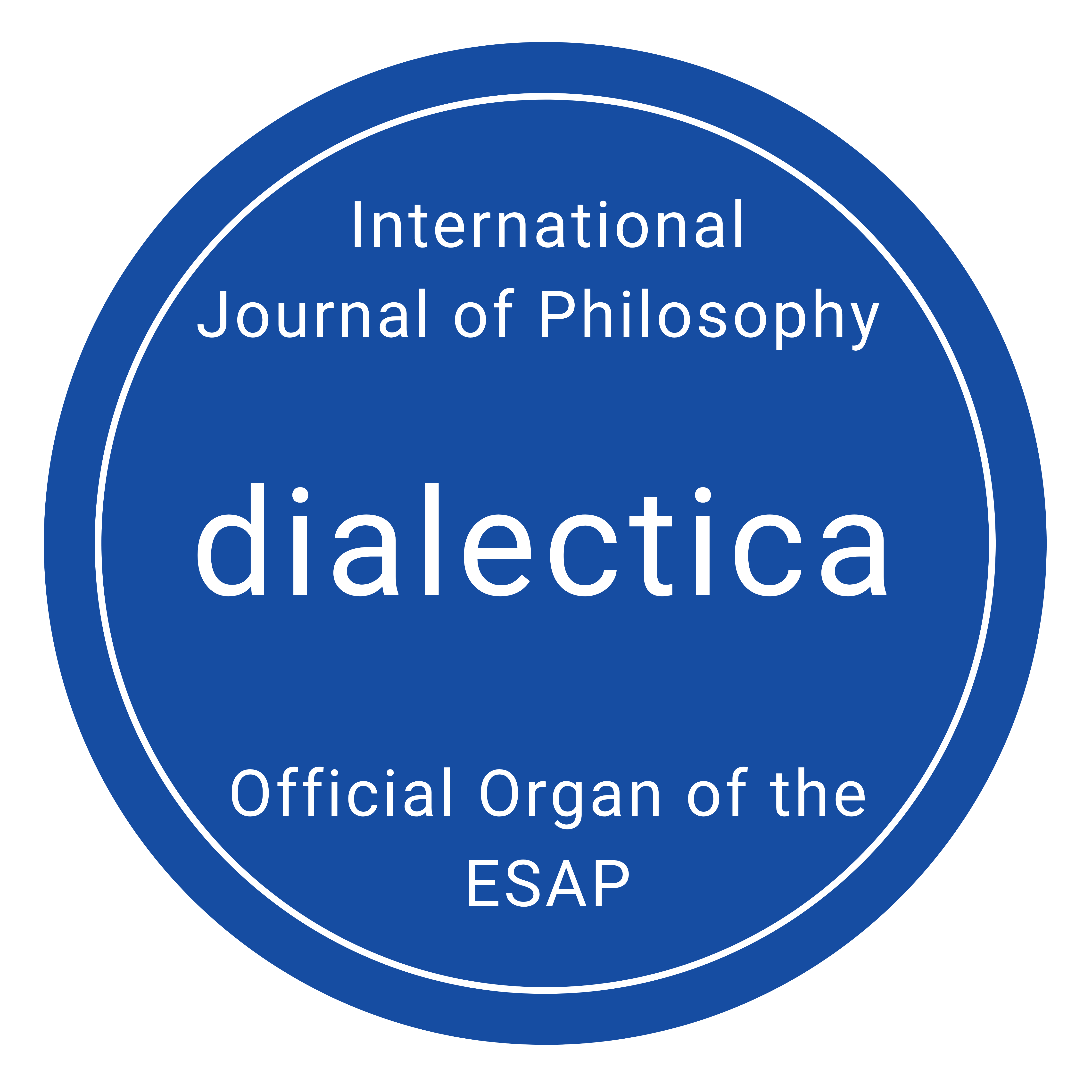References
Adams, Frederick and Clarke, Murray. 2005. “Resurrecting the Tracking Theories.” Australasian Journal of Philosophy 83(2): 207–221, doi:10.1080/00048400500111030.
Baumann, Peter. 2012. “Nozick’s Defense of Closure.” in The Sensitivity Principle in Epistemology, edited by Kelly Becker and Tim Black, pp. 11–27. Cambridge: Cambridge University Press, doi:10.1017/cbo9780511783630.004.
Becker, Kelly. 2007. Epistemology Modalized. Routledge Studies in Contemporary Philosophy n. 5. London: Routledge, doi:10.4324/9780203940341.
Becker, Kelly and Black, Tim, eds. 2012. The Sensitivity Principle in Epistemology. Cambridge: Cambridge University Press, doi:10.1017/cbo9780511783630.
Bjerring, Jens Christian and Gundersen, Lars Bo. 2020. “Higher-Order Knowledge and Sensitivity.” Canadian Journal of Philosophy 50(3): 339–349, doi:10.1017/can.2019.36.
Cogburn, Jon and Roland, Jeffrey W. 2013. “Safety and the True-True Problem.” Pacific Philosophical Quarterly 94(2): 246–267, doi:10.1111/j.1468-0114.2012.01454.x.
Crupi, Vincenzo. 2020. “Confirmation.” in The Stanford Encyclopedia of Philosophy. Stanford, California: The Metaphysics Research Lab, Center for the Study of Language; Information, https://plato.stanford.edu/archives/spr2020/entries/confirmation/.
DeRose, Keith. 1995. “Solving the Skeptical Problem.” The Philosophical Review 104(1): 1–52, doi:10.2307/2186011.
DeRose, Keith. 2004. “Sosa, Safety, Sensitivity, and Skeptical Hypotheses.” in Ernest Sosa and His Critics, edited by John Greco, pp. 22–41. Philosophers and Their Critics. Oxford: Blackwell Publishers, doi:10.1002/9780470756140.ch3.
DeRose, Keith. 2017. The Appearance of Ignorance. Knowledge, Skepticism, and Context, Vol. II. Stanford, California: Stanford University Press, doi:10.1163/22105700-20191398.
Enoch, David, Spectre, Levi and Fisher, Talia. 2012. “Statistical Evidence, Sensitivity, and the Legal Value of Knowledge.” Philosophy & Public Affairs 40(3): 197–224, doi:10.1111/papa.12000.
Hawthorne, John. 2004. Knowledge and Lotteries. Oxford: Oxford University Press, doi:10.1093/0199269556.001.0001.
Hawthorne, John. 2005. “The Case for Closure.” in Contemporary Debates in Epistemology, edited by Ernest Sosa and Matthias Steup, 1st ed., pp. 50–81. Contemporary Debates in Philosophy n. 3. Boston, Massachusetts: Blackwell Publishers. Second edition: Steup, Turri and Sosa (2014, 40–55).
Khoo, Justin. 2017. “Backtracking Counterfactuals Revisited.” Mind 126(503): 841–910, doi:10.1093/mind/fzw005.
Kripke, Saul A. 2011. “Nozick on Knowledge.” in Philosophical Troubles, pp. 162–224. Collected Papers n. 1. Oxford: Oxford University Press, doi:10.1093/acprof:oso/9780199730155.003.0007.
Lewis, David. 1973. Counterfactuals. Cambridge, Massachusetts: Harvard University Press. Cited after republication as Lewis (2001).
Luper, Steven. 1984. “The Epistemic Predicament: Knowledge, Nozickian Tracking, and Scepticism.” Australasian Journal of Philosophy 62(1): 26–49. Published under the name “Luper-Foy” , doi:10.1080/00048408412341241.
McGlynn, Aidan. 2012. “The Problem of True-True Counterfactuals.” Analysis 72(2): 276–285, doi:10.1093/analys/ans046.
Melchior, Guido. 2014. “A Generality Problem for Bootstrapping and Sensitivity .” Croatian Journal of Philosophy 14(40): 31–47.
Melchior, Guido. 2015. “The Heterogeneity Problem for Sensitivity Accounts.” Episteme 12(4): 479–496, doi:10.1017/epi.2015.31.
Melchior, Guido. 2017. “Sensitivity has Multiple Heterogeneity Problems: a Reply to Wallbridge (2017) .” Philosophia 45(4): 1741–1747, doi:10.1007/s11406-017-9873-5.
Melchior, Guido. 2019. Knowing and Checking: An Epistemological Investigation. New York: Routledge, doi:10.1007/s12136-022-00540-1.
Melchior, Guido. 2020. “Sensitivity Principle in Epistemology.” Oxford Bibliographies Online, doi:10.1093/obo/9780195396577-0404.
Melchior, Guido. 2021. “A Modal Theory of Discrimination.” Synthese 198(11): 10661–10684, doi:10.1007/s11229-020-02747-4.
Menzies, Peter. 2014. “Counterfactual Theories of Causation.” in The Stanford Encyclopedia of Philosophy. Stanford, California: The Metaphysics Research Lab, Center for the Study of Language; Information, https://plato.stanford.edu/archives/spr2014/entries/causation-counterfactual/.
Nozick, Robert. 1981. Philosophical Explanations. Cambridge, Massachusetts: Harvard University Press.
Pritchard, Duncan. 2012. “In Defence of Modest Anti-Luck Epistemology.” in The Sensitivity Principle in Epistemology, edited by Kelly Becker and Tim Black, pp. 173–192. Cambridge: Cambridge University Press, doi:10.1017/cbo9780511783630.014.
Roush, Sherrilyn. 2005. Tracking Truth. Knowledge, Evidence, and Science. Oxford: Oxford University Press, doi:10.1093/0199274738.001.0001.
Salerno, Joseph [Joe]. 2010. “Truth Tracking and the Problem of Reflective Knowledge.” in Knowledge and Skepticism, edited by Joseph Keim Campbell, Michael O’Rourke, and Harry S. Silverstein, pp. 73–84. Topics in Contemporary Philosophy n. 5. Cambridge, Massachusetts: The MIT Press, doi:10.7551/mitpress/9780262014083.003.0004.
Sosa, Ernest. 1999. “How to Defeat Opposition to Moore.” in Philosophical Perspectives 13: Epistemology, edited by James E. Tomberlin, pp. 141–153. Oxford: Blackwell Publishers, doi:10.1111/0029-4624.33.s13.7.
Starr, William B. 2019. “Counterfactuals.” in The Stanford Encyclopedia of Philosophy. Stanford, California: The Metaphysics Research Lab, Center for the Study of Language; Information, https://plato.stanford.edu/archives/spr2019/entries/counterfactuals/.
Vogel, Jonathan. 1987. “Tracking, Closure, and Inductive Knowledge.” in The Possibility of Knowledge. Nozick and His Critics, edited by Steven Luper, pp. 197–217. Lanham, Maryland: Rowman & Littlefield. Published under the name “Luper-Foy” .
Vogel, Jonathan. 1999. “The New Relevant Alternatives Theory.” in Philosophical Perspectives 13: Epistemology, edited by James E. Tomberlin, pp. 155–180. Oxford: Blackwell Publishers, doi:10.1111/0029-4624.33.s13.8.
Vogel, Jonathan. 2000. “Reliabilism Leveled .” The Journal of Philosophy 97(11): 602–623, doi:10.2307/2678454.
Wallbridge, Kevin. 2017. “Sensitivity hasn’t Got a Heterogeneity Problem: a Reply to Melchior (2015).” Philosophia 45(2): 835–841, doi:10.1007/s11406-016-9782-z.
Wallbridge, Kevin. 2018. “Sensitivity, Induction, and Miracles.” Australasian Journal of Philosophy 96(1): 118–126, doi:10.1080/00048402.2017.1328697.
Walters, Lee. 2016. “Possible World Semantics and True-True Counterfactuals.” Pacific Philosophical Quarterly 97(3): 332–346, doi:10.1111/papq.12067.
Williamson, Timothy. 2000. Knowledge and Its Limits. Oxford: Oxford University Press, doi:10.1093/019925656X.001.0001.
Zalabardo, José L. 2016. “Reflective Knowledge and the Nature of Truth.” Disputatio 8(43): 147–171, doi:10.2478/disp-2016-0009.
Further References
Sosa, Ernest and Steup, Matthias, eds. 2005. Contemporary Debates in Epistemology. 1st ed. Contemporary Debates in Philosophy n. 3. Boston, Massachusetts: Blackwell Publishers. Second edition: Steup, Turri and Sosa (2014).
Steup, Matthias, Turri, John and Sosa, Ernest, eds. 2014. Contemporary Debates in Epistemology. 2nd ed. Contemporary Debates in Philosophy n. 3. Malden, Massachusetts: Wiley-Blackwell. First edition: Sosa and Steup (2005), doi:10.1002/9781394260744.
